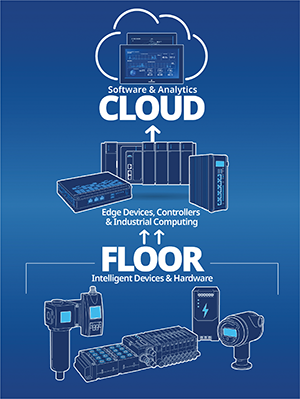
Manufacturing is undergoing a major shift in terms of how it adopts automation technology to achieve operational improvements. It is evolving beyond the deployment of individual smart components, to instead implement entire digital ecosystems that converge information technology (IT) and operational technology (OT). That doesn’t mean legacy automation solutions need to be replaced. Existing components and the various vertical automation layers of a production environment are instead linked within a factory-wide digital ecosystem. Fundamentally, devices that create the right data add greater value when they can interact with other automation components. Equally, modern software cannot support improvements without leveraging additional data. Only by integrating hardware and software into a digital ecosystem can manufacturers obtain real added value.

The automation architecture currently used by manufacturers will need to transition to ensure data from sensors and hardware within the operational technology (OT) layers is integrated appropriately with the information technology (IT) layers. In addition, the people who operate in each layer will need to expand their skill sets or leverage new digital tools that enable greater connectivity. Today, unoptimised connectivity of the OT and IT layers presents a barrier to meaningful data use because there are separate layers of automation and network architectures. Modern automation architectures enable manufacturers to manage, connect and deliver OT and IT data seamlessly across their plants. Data is gathered from devices and modern edge-based technology control systems, and securely moved to today’s cloud-based enterprise for analysis, trending and forecasting. This supports efforts to optimise the process, reliability, safety and sustainability.
However, because every manufacturing company is different, this requires not only a common set of principles and specifications, but also flexible automation architecture that can be configured to the specification of each manufacturer. Architecture flexibility is important, not only in terms of providing the opportunity to start small and scale up, but also supporting adjustment of production lines to meet changing market demands.
Smart devices and sensors, controllers, and edge computing hardware and analytics software enable existing machines and processes to be optimised, and workforces to achieve ambitious productivity and safety goals, and companies to meet their sustainability targets. Using a methodology such as Emerson’s Floor to Cloud approach, manufacturing data is acquired, translated and presented by modern human machine interfaces to provide insights into a plant’s condition and performance. The aim of a floor to cloud approach is to acquire real-time data to enable manufacturers to identify optimisation opportunities and continuously improve operations. By implementing advanced sensor technology, analysis software and networking solutions, manufacturers and original equipment manufacturers (OEMs) can access and analyse machine data. Critically, real-time diagnostics are possible, which provides the opportunity to improve overall equipment effectiveness (OEE), sustainability and production safety.
Access to data
A key element of a floor to cloud approach is to reduce the technology barrier to entry, while enabling the access to data for the right range of users. By extending the availability of real-time operating data from an individual device or system, not only manufacturers, but also OEMs and automation vendors can identify issues and make informed decisions that positively impact the management of a plant. For example, real-time trends and diagnostics can be used to perform predictive maintenance processes that improve equipment availability or analyse root causes to achieve better product quality and continuously optimise systems and operational production processes. Utilising external expertise from the machine builder or automation vendor can supplement an in-house maintenance team. It is also very important to get access to this data without having to redesign an entire machine. Equally, users want to perform analysis and optimise machines without having to access the data from a control system. The use of smart gateways and edge controllers that support both deterministic control and analytical software helps to achieve this.
A typical floor to cloud approach incorporates intelligent devices and individual components connected to controllers, edge devices or gateways. Automation vendors don’t offer solutions for every production environment, but standard communication protocols allow components from different companies to connect and operate within the digital ecosystem. The technology must be as easy as possible to implement. These devices are IIoT-ready, with appropriate interfaces for communication via OPC UA or IO-Link. Software solutions such as PACEdge or Movicon from Emerson offer similar connectivity, and can present analysed data to support predictive maintenance strategies, optimisation of OEE, or reduced energy consumption.
| Tel: | +27 11 451 3700 |
| Fax: | +27 451 3800 |
| Email: | [email protected] |
| www: | www.emerson.com |
| Articles: | More information and articles about Emerson Automation Solutions |

© Technews Publishing (Pty) Ltd | All Rights Reserved